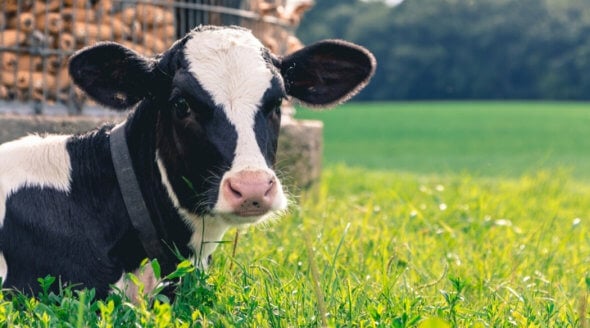Mohair: Goats Abused and Killed
Mohair – the long, smooth fibre used for clothing, accessories, and soft furnishings – is taken from angora goats who are forced to endure the extremely stressful process of shearing. Bred primarily for their soft inner coats, their first shearing usually occurs at the tender age of 6 months, and they’re often mutilated, roughly handled, and thrown around before ultimately being slaughtered. Over 340 brands have banned mohair from their collections, but many other retailers and manufacturers are yet to follow suit.
Newborn Goats Face Painful Mutilations
On some farms, kids – baby goats – are dehorned at just 1 or 2 weeks old. Workers burn off their horns with a hot iron or by applying a caustic chemical paste, which can cause severe burns or blindness if it gets on the animals’ skin or into their eyes. Male kids also endure painful testicle removal using rubber rings, which can leave them in distress for days and often leads to tetanus infection. These procedures are usually carried out without any pain relief.

Shearing: Goat Kids Cry Out in Fear
Goats are prey animals, which means that when faced with danger, their instinct is to flee, not fight. Being pinned down by workers during the shearing process is especially terrifying for them, as they feel vulnerable and defenceless, with no means of escape. A disturbing PETA Asia investigation into the mohair industry in South Africa revealed that goat kids who were being shorn for the first time cried out in fear. Some shearers lifted the animals up off the floor by the tail, likely breaking it at the spine. When one goat struggled, the shearer sat on her. After shearing, workers threw the animals across the wooden floor and hauled them around by the legs.
In the mohair industry, workers are paid by volume, not by the hour, so they’re driven to work quickly and carelessly. The investigative footage showed that shearers cut broad swathes of skin off some animals – and crudely stitched up the most gaping wounds right there on the filthy shearing floor, without providing any pain relief whatsoever.

Neglected Goats Die From Exposure to the Elements
Shearing robs angora goats of their natural insulation, and unlike sheep, they don’t carry layers of body fat. They are extremely sensitive to changes in temperature – severe winds and rain can kill them, even when temperatures aren’t particularly low. Goats who are shorn in the winter may die of pneumonia, especially when neglected and left without shelter. One farmer told PETA Asia’s eyewitnesses that in just one weekend, 40,000 goats died from exposure across South Africa. Another said that up to 80 per cent of goats die after shearing on some farms.

Goats Deemed Unprofitable Are Slaughtered
Goats who survive repeated shearing are killed well short of their natural 10-year life expectancy – as soon as they’re no longer useful to the industry because they can’t reproduce or because drought, illness, or several years of rough shearing have reduced the quality or regrowth rate of their hair. They’re often shorn one final time before being sold for meat, or they may be slaughtered for their skin, which is used to produce clothing, accessories, rugs, and other items. The animals are crammed into lorries for transport to slaughter and may be subjected to journeys as long as 35 hours to get to market.
In South Africa, 90 per cent of surviving angora goats are sold for crude backyard slaughter. On one farm, a worker slowly cut the throats of fully conscious goats with a dull knife and then broke their necks. He hacked one animal’s head right off. Another remained conscious and was kicking for more than a minute after the worker made his first cut.
Other goats are hauled to abattoirs. On the killing floor that the eyewitness visited, goats were jolted with electricity, hung upside down by one leg, slashed across the throat, bled, and skinned.
Some producers and retailers claim that the animal hair and skin they sell are “by-products” of the meat industry. But angora goats are raised specifically for their coats and may not survive long enough to make it to slaughter.

What You Can Do
- The best thing that you can do for angora goats is to refuse to buy mohair. It’s easy to check the label when you’re shopping. If it includes the word “mohair”, leave the item on the shelf. Instead, opt for animal-free alternatives, like the ones on this list. You can find a list of well-known companies that have banned mohair here.
- Sheep, cashmere goats, rabbits, antelopes, alpacas, and other animals are victims of the fashion and soft-furnishings industries, too, so please also steer clear of wool, cashmere, angora (from angora rabbits), and all other fibres that are stolen off animals’ backs.

